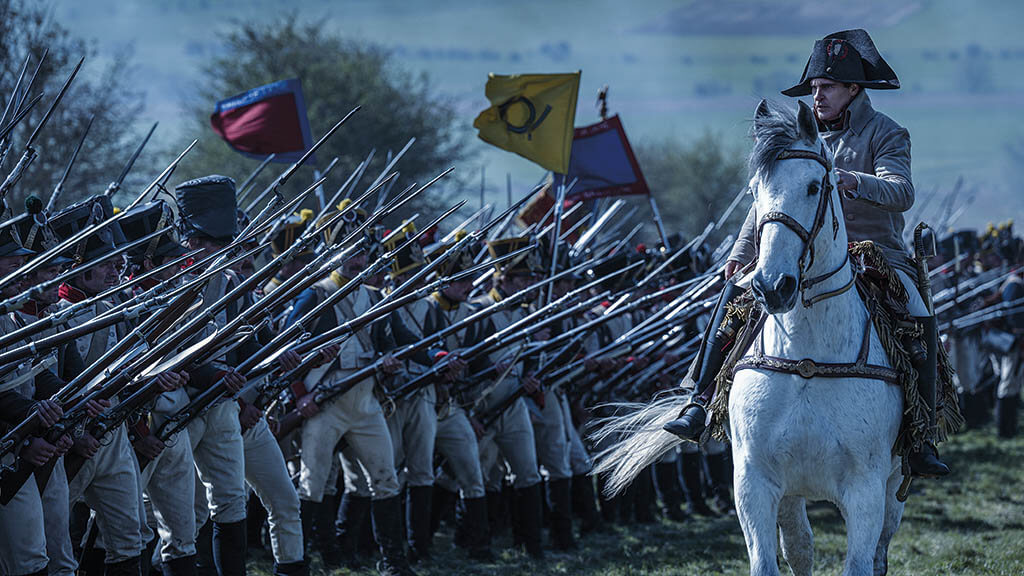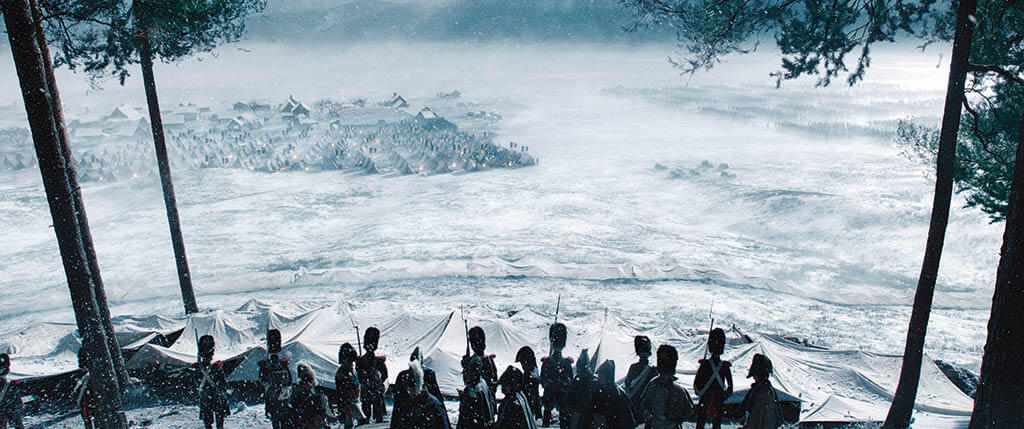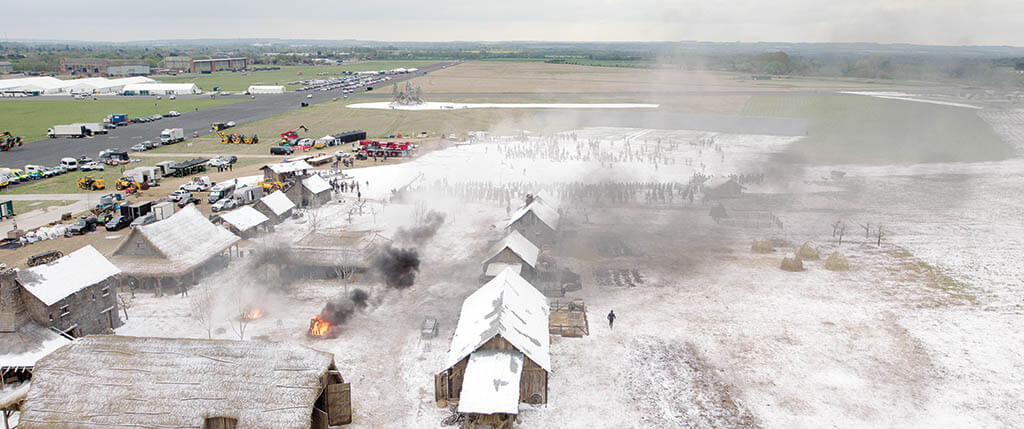By TREVOR HOGG
Images courtesy of Apple Studios and Columbia Pictures.
By TREVOR HOGG
Images courtesy of Apple Studios and Columbia Pictures.

Hundreds of extras had to be turned into thousands of troops for the battlefield scenes.
There are no signs of Ridley Scott slowing down, as he released The Last Duel and House of Gucci in 2021, and upon completing Napoleon immediately went into pre-production for Gladiator 2. “Normally, Napoleon would be an 18-week shoot, and we did it in something like 10 weeks,” marvels Neil Corbould, Special Effects Supervisor. “It was incredibly fast, and it’s the pace that Ridley works at.” No one is better prepared than the octogenarian filmmaker. “Ridley does all of his own storyboards, and they’re so precise; he’ll draw little explosions or cannons or rifles,” Corbould observes.
Napoleon explores the life of Napoleon Bonaparte from becoming the Emperor of the French to his tumultuous love affair with Joséphine de Beauharnais, and his military campaigns in Europe, Russia and Egypt. “There is a myth that in the Battle of Toulon that Napoleon’s horse was hit by a cannonball, and there isn’t a massive amount of reference about that,” Corbould says. “Ridley heard it from one source and wanted to do that as much practically as he could with an animatronic horse, which we did with a rider on it. It’s a big mix of special effects and visual effects to get the shot.” Air blasts were buried on the battlefield for the Battle of Waterloo. “The first time we showed Ridley, he thought that we had blown the stuntman up! It was that realistic. The guy came out with a bit of peat on his head. Ridley loved it after that. We used those all of the time. It was so safe,” Corbould adds.
“It’s 18th century France, which is different from some of the futuristic projects that I’ve done with Ridley and earlier periods, like Gladiator,” explains Arthur Max, Production Designer. “Each historical period has its own visual vocabulary. I got interested in the challenge of the practical limits. We didn’t go to France. It was England and Malta. You get your architectural reference book out and start to look at what the architectural language is of the French, 18th century and earlier.” A partnership was forged between the visual effects and art department. Max explains, “This is a big canvas with battlefields, with hundreds of thousands of troops involved historically, and we’re just dealing with hundreds of extras. From my point of view, you have to design what’s not there as well as what is there. We built a lot of physical sets and relatively large ones in some cases. The ones in Malta were very big constructions. For the Battle of Toulon, we couldn’t build everything. It’s a combination of the set extension that Charley Henley [Visual Effects Supervisor] did, but we tried to indicate as much as possible what they are with the same set of levels of design drawings that we do for the built sets, so that the visual effects department knows how to join them together so they match seamlessly.”
Electricity was nonexistent, which meant a heavy reliance on candlelight with some digital assistance. “It was not always possible to shoot with real candlelight,” describes Dariusz Wolski, Cinematographer. “Because of shooting in real estates with 18th century paintings on the wall, we were restricted in using real candles. That was a big deal which was slowly creeping up on me during prep. I found this little LED filament and created fake candles that were on dimmers. The poor set decoration department; they did tons of chandeliers. What I did with Charley was to photograph a lot of real candles to put the flames on the fake ones. That was quite remarkable to me. You get a few scenes where some of them being completely out of focus in the background were real because they looked fine. Otherwise, they are all replaced. We always tried to have real candles close by.” Visual effects were involved from the first location scout. “From the beginning, Charley was part of the creative process, and he created his own previs that Ridley looked at and corrected. That’s the prep. We’re always discussing what should be done for real or needs his help.” Bluescreen was avoided as much as possible. “A lot of times in those big battles, we had 30 x 20 frames and ended up using grey because once you set everything up it disappears and gives you another dimension,” Wolski adds.

BlueBolt added CG ships around a practical one for the Battle of Toulon.
In the middle of principal photography was Richard Bain, On-Set Visual Effects Supervisor. “Charley, Sarah Tulloch [VFX Producer] and I talked about how to represent scale and perspective on the battlefield. We felt that having markers in the shape of soldiers dotted around the field would assist where we would otherwise have no reference in an empty landscape. A similar idea was used on Sergei Bondarchuk’s version of Waterloo [1970] where he used groups of mannequins in battle dress mounted in a line on a pole and carried by two soldiers at either end, to help swell the numbers in the distance.” Various approaches were used to capture the necessary crowds for scenes. “On some of the battle scenes, we would peel off one or two SAs [Supporting Artists] away from the main group to assist in scale and perspective for our digital doubles. We had to limit the number of SAs due to the COVID-19 restrictions. We would shoot stunt fight sprites on set between setups so we had the same lighting conditions. However, when we had so many cameras shooting at different angles in disparate positions, it’s difficult to know how to quantify the use this had for each camera setup. Hence, we needed to wait for an edit to then set up shot specific groups to match camera angles, which became a visual effects and pick-up shoot at a later date.”

It was important during the battle sequences to clearly depict the strategic genius of Napoleon Bonaparte.

When Ridley Scott initially saw footage of the exploding air mortars, he actually thought that the stunt performer had been blown up.

The shadows in the Battle of Toulon cause audience members to fill in the visual gaps with their imagination.


A village was constructed on the airfield at RAF Abingdon in England for the Battle of Austerlitz.
Approximately 1,046 visual effects are in the final cut and were created over a period of 30 weeks by MPC, ILM, BlueBolt, Outpost VFX, One of Us, Light VFX, an in-house team, PFX, Ghost VFX, The Magic Camera Company, Argon and The Third Floor. The biggest visual effects challenge were the crowds; second was the architecture and third was nature, which includes animals and weather. “We brought in architect Inigo Minns as a consultant and researched the buildings that we shot on, the real buildings where that a historical event happened in, and how the architecture married up,” remarks Charley Henley, Visual Effects Supervisor. English roofs had to be digitally altered to reflect the French mansard style; windows had to be changed, and in some cases the color of the stonework had to be shifted. “We also added buildings on skylines but a lot of it was working off the buildings that were there already,” Henley notes.

Shooting with multiple cameras enabled filmmaker Ridley Scott and Cinematographer Dariusz Wolski to get the necessary coverage without having to do numerous setups that would slow down the production.
There were some unexpected visual effects. “One of these surprise ideas was, ‘We need to have dogs in this interior scene,’ the scene where Napoleon goes into the Kremlin and sits on a throne. We went off auditioning all of our friends’ dogs. Ridley commented, ‘I need a lot of pigeons in here.’ We never had enough pigeons! Then it’s like, ‘We need the pigeon poop all over the place,’ so we’d go shoot more elements,” Henley explains. Atmospherics were another critical component of nature effects. “Neil Corbould did massive amounts of practical effects which we augmented. It was always more work on wide shots, but with the 14 cameras, some of them get the smoke and others miss it; there’s a whole layer of continuity to deal with,” Henley says.
Looking after the Battle of Waterloo, Napoleon’s horse getting hit by a cannonball and the Kremlin was MPC. “The costume designer [Janty Yates] did a tremendous job of making sure that every single military uniform was unique,” notes Luc-Ewen Martin-Fenouillet, VFX Supervisor at MPC. “They had their own backpacks and rifles with different levels of grime and dust. The first thing we talked about with Charley was that our CG army needs to look at least as good as the on-set one. Then, we had to make sure that the army behaved and moved the same way the plates were behaving and moving.”


The hillside footage of Napoleon looking out at the frozen lake during the Battle of Austerlitz was captured at Bourne Wood.

Miniature ships were created by The Magic Camera Company for the Battle of Toulon that were subsequently shot catching fire and having cannonballs ripping through them.


The practical and digital snow effects were extensive for the Battle of Austerlitz as the sequences were shot during the summer.


The hardest part of the crowd simulations for the Battle of Austerlitz was making sure that the digital soldiers were indistinguishable from those on set.


63,539 variations were created for the soldiers along with a huge library of mocap motion clips by ILM for the Battle of Austerlitz.
Horses proved to be more difficult than the soldiers. Martin-Fenouillet remarks, “Having a biped on top of a quadruped and getting it simulated so that the cloth and groom flows when the horse runs or stops or falls was painful. Very quickly, we learned that a horse only looks as good as the mane and tail that comes with it. Those pieces always had to have movement and be interlocking, whether it’s from the wind or action or the motion of running horses. Getting all of those dynamics to the next level added to the believability.”
A decision was made early on to tone down the smoke on the battlefield. “The story had to be told first. We had to be able to read the strategies and the different beats of which army goes where and does what. Whenever the crowd agent was physically pulling the trigger, it would generate a muzzle-flash cache of smoke that would drift to the wind it was set to. We had a way of previsualizing it in Houdini so you could get the timing right. For the cannons, it was more complex because Ridley had a specific choreography in mind. We decided on the speed of the cannonball then figured out that it only worked for some specific angles. In the end, it was mostly hand-animated to tell the story,” Martin-Fenouillet says.
ILM handled the Battle of Austerlitz and March to Moscow, with the former requiring three different locations being blended seamlessly together to create an environment surrounding a frozen lake which subsequently gets blown apart by French cannon fire. “They had to create previs for all of these locations to make sure that everything was working right,” states Simone Coco, VFX Supervisor at ILM. “An amazing, massive real set was built for the village on the airfield. It was nice being on the battlefield back in the18th century. That was the main part of where the battle happened. They shot in Bourne Wood for the hillside where Napoleon is watching the battle with hidden cannons. Then we shot the water tank at Pinewood Studios for the end of the sequence where the Russian soldiers get killed running away from the French infantry and get shot by the cannons from the hill.” Despite being set in the winter, the footage was actually captured during the summer and required lots of practical snow. Coco notes, “It was quite cloudy sometimes, so we were lucky with the weather.” Fog is a major part of the Battle of Austerlitz because it hid the French Army from the Russians and Austrians. He adds, “When there’s a lot of wind, sometimes you get sun spill even if it’s snowing, so we played with that idea. Our job was mostly extending what they shot.” About 63,539 variations were created for the soldiers, along with a huge library of mocap motion clips. “There is no one who looks the same,” Coco states. To get the correct interaction, actors were captured with ice made out of polystyrene. “The layout artists had to track every single piece that they shot, replace it with a proper ice sheet, and then the effects artists would create water and snow explosions and debris,” he explains.
The Battle of Toulon and Paris riots were the responsibility of BlueBolt. “The Battle of Toulon is a long sequence,” remarks Henry Badgett, VFX Supervisor at BlueBolt. “There was a lot of to-and-fro in the editing to get all of the beats working and not overcook it. It’s an introduction to what a genius Napoleon is as a strategist and how that wins battles for him. From our point of view, we were trying to make visual sense of this onscreen without being too obviously descriptive. Working on night shots of battles is quite nice because of the chaos, and you want to leave some to the imagination due to the shadows. That in itself can be quite hard to do when you’ve got nighttime and smoke lit by fires that are coming and going. When you get the grayscale CG renders in, you can see clearly that this building is here and that one is over there and a ship over there. Then, it’s about completely losing that image when comping it, and you’re trying to persuade the compositor to do less. You just want to see a hint of whatever is back there.”
Miniature ships were created by The Magic Camera Company that were subsequently shot catching fire and having cannonballs ripping through them. Badgett adds, “When you shoot elements like that you always get something unexpected for free, so you pick that and put it in. That’s your hero piece, and you can surround it with CG stuff.” The land environment was slightly easier than looking out at sea. He notes, “When out at sea, we’re making more of it from scratch. For the land, 75% would already be there, and we would be adding the extra 25% of chaos, atmosphere and gunfire.”
“I’d be interested how people react to the Battle of Waterloo,” Henley says. “That was crazy and a bit terrifying mainly because we had the most cameras, the biggest number of real crew, and the weather was amazing but unpredictable. In one day, we had rain, hail, sun, clouds, moody skies, wind and then nothing. It was a mad weather pattern that we were shooting in. However tough, what was amazing was that it gave us reference for everything Ridley wanted for the scene.” The most impressive moment for Max is the coronation of Napoleon. “We referred to the Jacques-Louis David painting, which is well-known as historical paintings go, and tried to bring that to life.” Napoleon was a terrific experience for Corbould. “They’re not going to be making movies like this much longer because the directors who can direct them are getting fewer and farther between. We have to make the most of it while we can.”